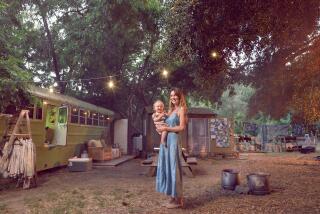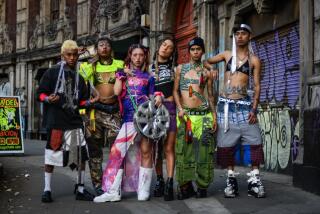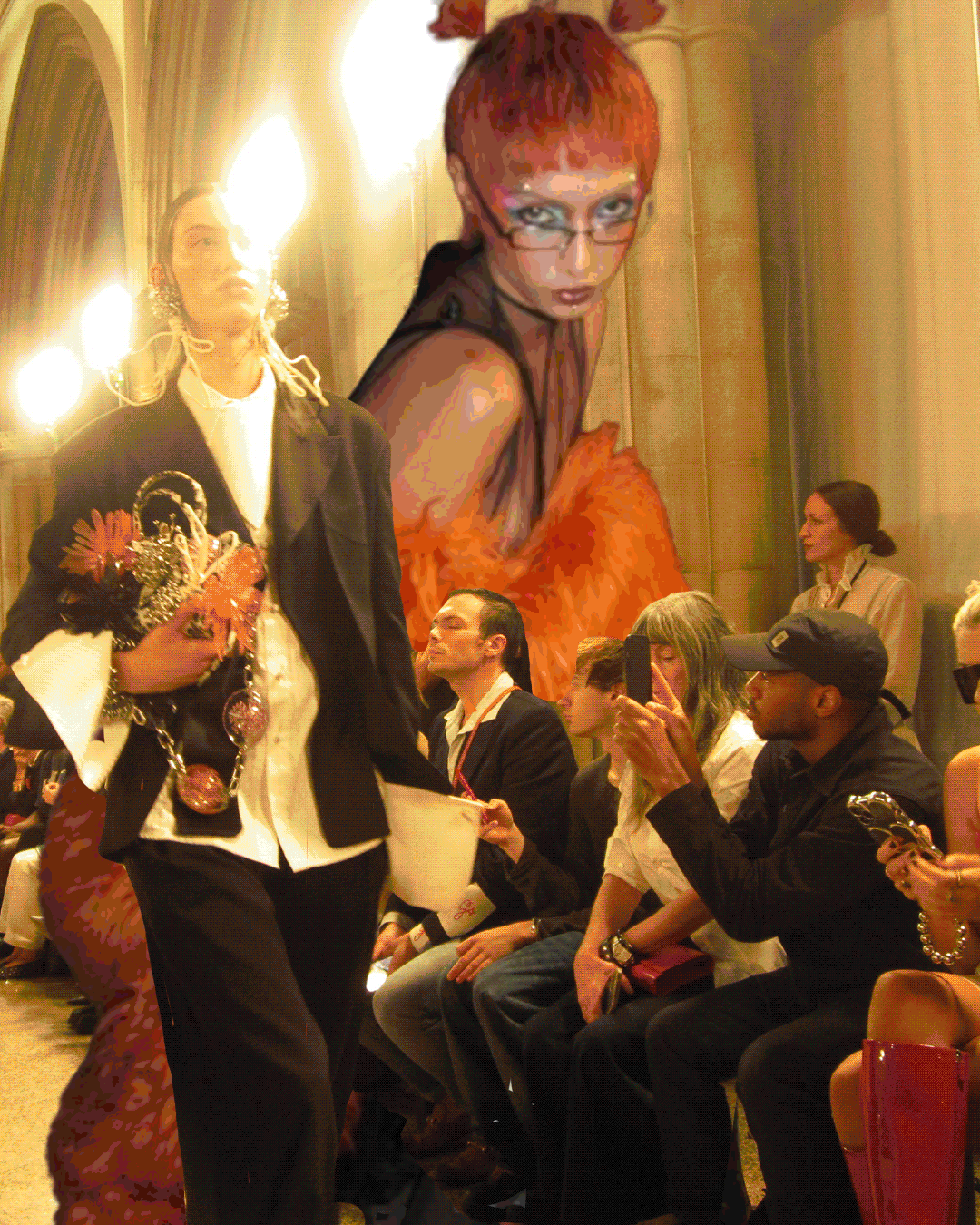Breakout art star Gabriela Ruiz plays with body and identity in her first solo show
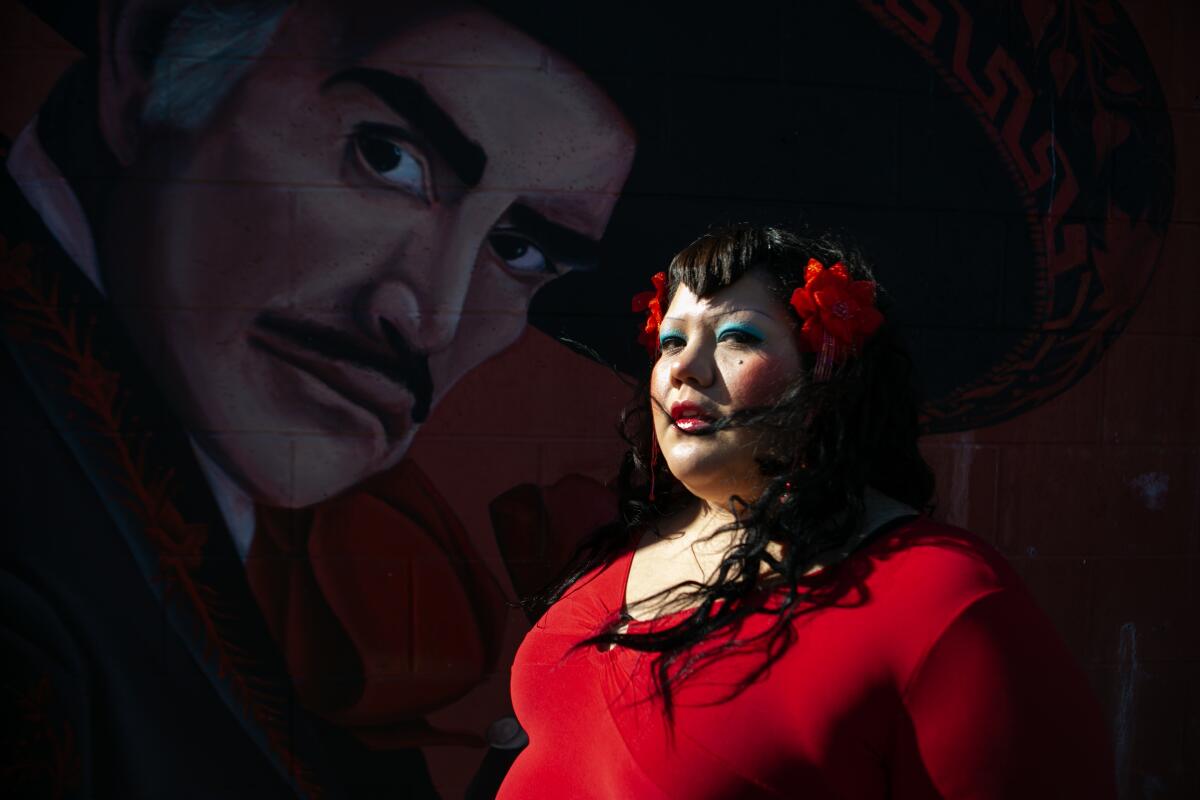
- Share via
The setting: Rincon Taurino, a flamboyantly decorated Mexican restaurant in Panorama City where every available surface, including the garbage cans, has been covered in toreador art.
Enter Gabriela Ruiz, who lands like a performance-art glamour rocket, clad in sunglasses and bearing a large, lemon-yellow handbag.
An ebullient “hello” is delivered in a lightly raspy voice. Her equally ebullient clothing ensemble soon comes into full view: velvet pants in eggplant purple paired with a red body suit, crimson silk flowers over either ear and sky-blue eye shadow, generously applied.
The artist, 28, has been dressing to impress ever since attending Ulysses S. Grant High School in Van Nuys.
“In middle school and high school I figured out that by dressing up cool and having a sick style, you could be cool,” she says. “The skinny girls were like, ‘Oh, you look cool.’ They wanted to be your friend. They wouldn’t pick on you.”
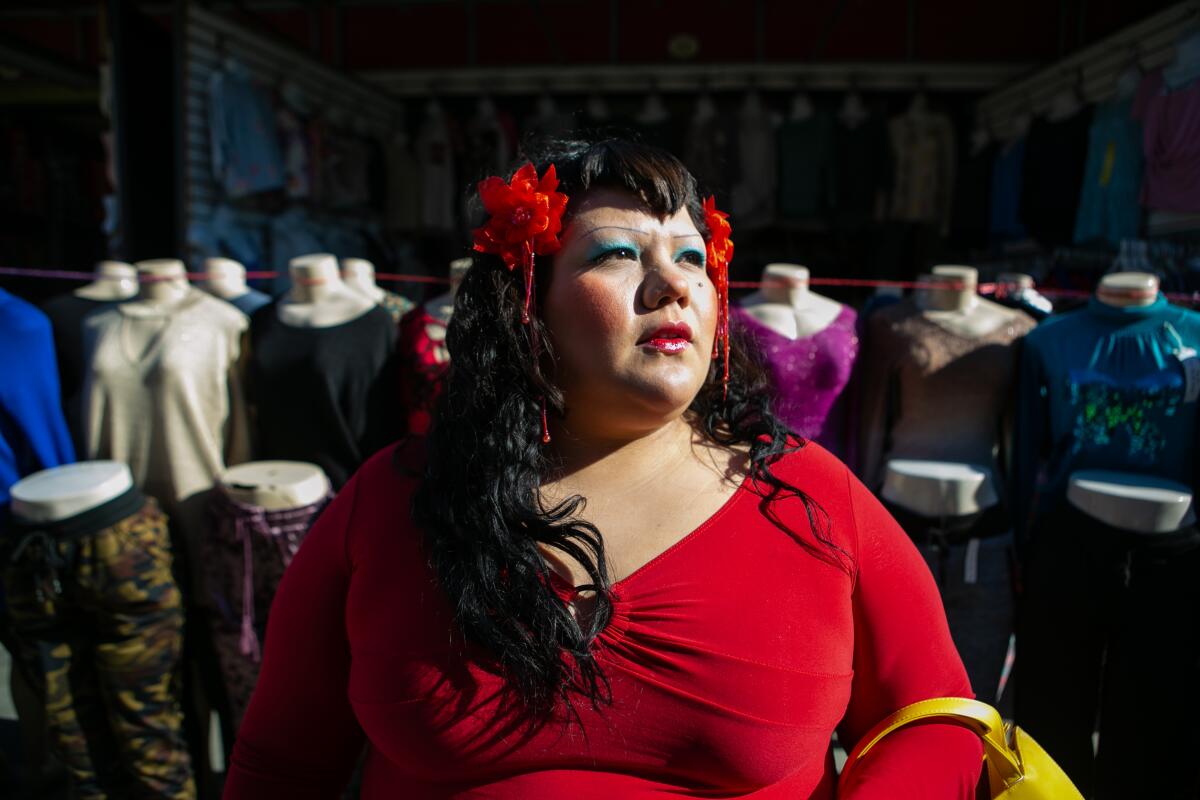
Ruiz’s style has always been 100% DIY.
“I once made this headband and glued my mom’s pill bottle to it and filled it with Smarties,” says Ruiz. She then proceeded to run around school with a pill bottle rattling on her head. This did not impress her teacher, who told her, “‘Get out of here! Why are you promoting drug habits?!’”
Ruiz erupts in infectious laughter recalling the incident.
The line between Ruiz and her art is a thin one. Her life, her looks and her body all regularly appear in her work — performances, video and installation — that dwell on issues of desire, longing, identity and family, not to mention a keen fascination with deeply saturated color hues.
You are walking into my brain and seeing what I see.
— Gabriela Ruiz, artist
As part of this, she maintains a lively Instagram channel (@gabrielaxruiz) that is as much a documentation of her work as it is a work itself. On her feed, you will find an image from a nude performance in Antwerp, Belgium, where Ruiz bathed herself on a bed of Zote laundry soap, touching on issues of domesticity and labor. In another, she poses on the streets of Mexico City wearing a wig made out of a rainbow of pompom balls.
For the artist, art is life and vice versa.
Ruiz is certainly fully present in her first solo museum exhibition, “Full of Tears,” on view at the Vincent Price Art Museum, where she has transformed a gallery space into a surreal chamber of dreams.
It starts with the walls, which are painted acid-green. These harbor a window frame draped in red velvet that features projections of family photographs and incidental videos, all set to a scrambled soundtrack of music and ambient sound.
On a far wall hangs a cast of Ruiz’s body, with the head placed between the legs, a surveillance camera inserted into the mouth. In another corner, a set of three doors serve as sculptural screens for images of psychedelic landscapes and digital manipulations of the artist’s face and body (done in collaboration with digital artist Derek Holguin and musician Andrew Eastman).
It’s as if the artist has picked herself apart and invited the viewer in. “This was like me opening my doors to you,” says Ruiz. “You are walking into my brain and seeing what I see.”
“There’s a story of family and rapture there,” says VPAM director Pilar Tompkins Rivas of the installation. Plus, the sonic elements provide a sensation of what it means to navigate L.A. “Like you’re driving down the street and you catch a bit of cumbia or you’re walking down Santee Alley and you catch all of these sounds.”
There is also an outsized ambition, especially for an artist who has been working in performance and installation for only a handful of years. “She has a clear vision,” Tompkins Rivas says. “She knew the level of experimentation she wanted to meet.”
Currently she is at work on a closing performance for the show, organized by VPAM and Bermudez Projects, that will take place at Civic Center Studios in downtown L.A. on Feb. 13.
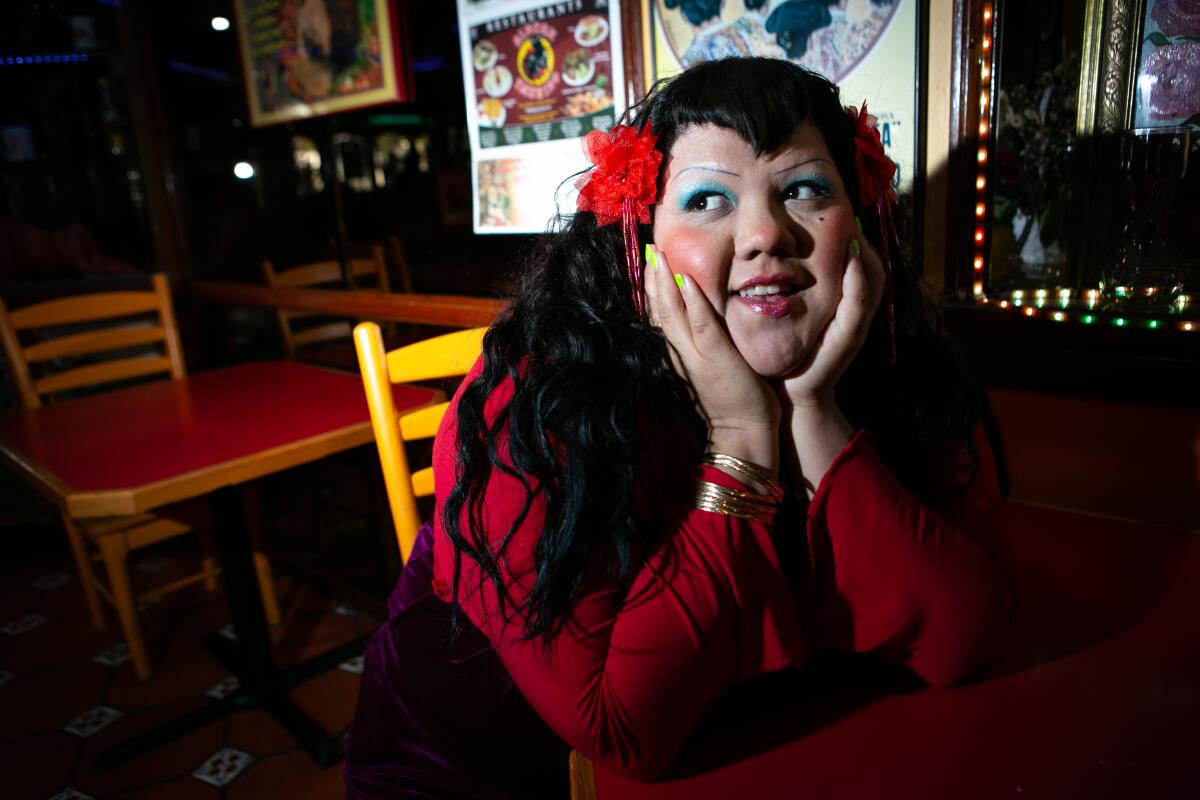
Though she now lives in L.A.’s Chinatown, Ruiz wanted to go back to the San Fernando Valley for this interview — hence the meeting at Rincon Taurino, a favorite of hers. (She is a fan of the birria; served only on weekends.)
Specifically, she was interested in returning to the area around Van Nuys Boulevard, a place that is significant to her personally, but also to the popular culture at large. The artist cites the 1979 cruising flick “Van Nuys Blvd.,” about kids who manage to pull one over on the authorities and get laid while driving sweet rides. (Prominently featured is a souped-up ‘63 Ford Econoline van that makes the film an important exemplar of the 1970s cinematic genre known as “vansploitation.”)
“When I was younger, I was a weird movie buff,” Ruiz says of how she first stumbled into the film. “And I wanted to know the history of Van Nuys — and ‘Van Nuys Blvd.’ came up. ... I’m super proud of where I come from and where my family is from.”
Born in Sylmar to working-class Mexican immigrants from Michoacán and Mexico City, Ruiz says she never imagined that art would be the thing for which she’d become known. Her earliest inspirations were music videos, with their vivid sets and wild fashion. “I always said I wanted to be a fashion designer first,” she says.
And, for a time, she was — creating one-of-a-kind pieces under the name Leather Papi, inspired by her interest in BDSM. “I was interested in the aesthetics of it,” she says. “I was always into Bettie Page. And you go from there to illustrator John Willie. Now you have this ideal of the hourglass woman in high boots and leather.”
Ruiz, however, was interested in designing for a wider range of body types, and for the circle of queer and brown artists she hung out with (groups not always represented in the aesthetics of bondage).
The project was pretty much a labor of love.
“It was just trial and error,” she says. “I didn’t have the money to produce 100 hoodies so someone could order them. I was just doing made-to-order and that is really exhausting. I was sewing. I was screen-printing. I was making my own labels.”
Ruiz was even making the colorful sets for her fashion shoots, which served as a precursor of sorts to her installation art. (Beyond a few art classes at Los Angeles Valley College, Ruiz never got a degree. She declares: “I sucked at school.”)
Her connection to the art world came by chance, when she began frequenting Mustache Mondays, the queer dance party/performance happenings organized by the indefatigable Ignacio “Nacho” Nava Jr. in downtown Los Angeles.
She and Nava became acquaintances, then friends. Soon, she was working the door. “I know every excuse in the book for someone not having money,” she says.
Before long, she was staging performances. It was through Nava that Ruiz met artist Rafa Esparza, with whom she would collaborate on a performance-procession through Santee Alley as part of Esparza’s solo show at the Institute of Contemporary Art, Los Angeles in 2018.
She also connected with artist Nao Bustamante, vice dean of the art school at USC, who invited her to create a work for a performance festival in connection with PST: LA/LA. For that event, Ruiz, decked out entirely in red, wore a 50-foot-long braid of red hair that a collaborator used to toss her to the ground. Peekaboo Jenkins, a cellist friend, supplied the avant-garde soundtrack.
The USC event gave her credibility. “I credit Nacho with that,” she says, a knot of emotion in her voice. “He’s the reason I met everyone. ... He made you believe that what you were doing was important.”
Nava died of pnuemonia last year at the age of 42. Ruiz’s exhibition at VPAM bears a wall text in his honor.
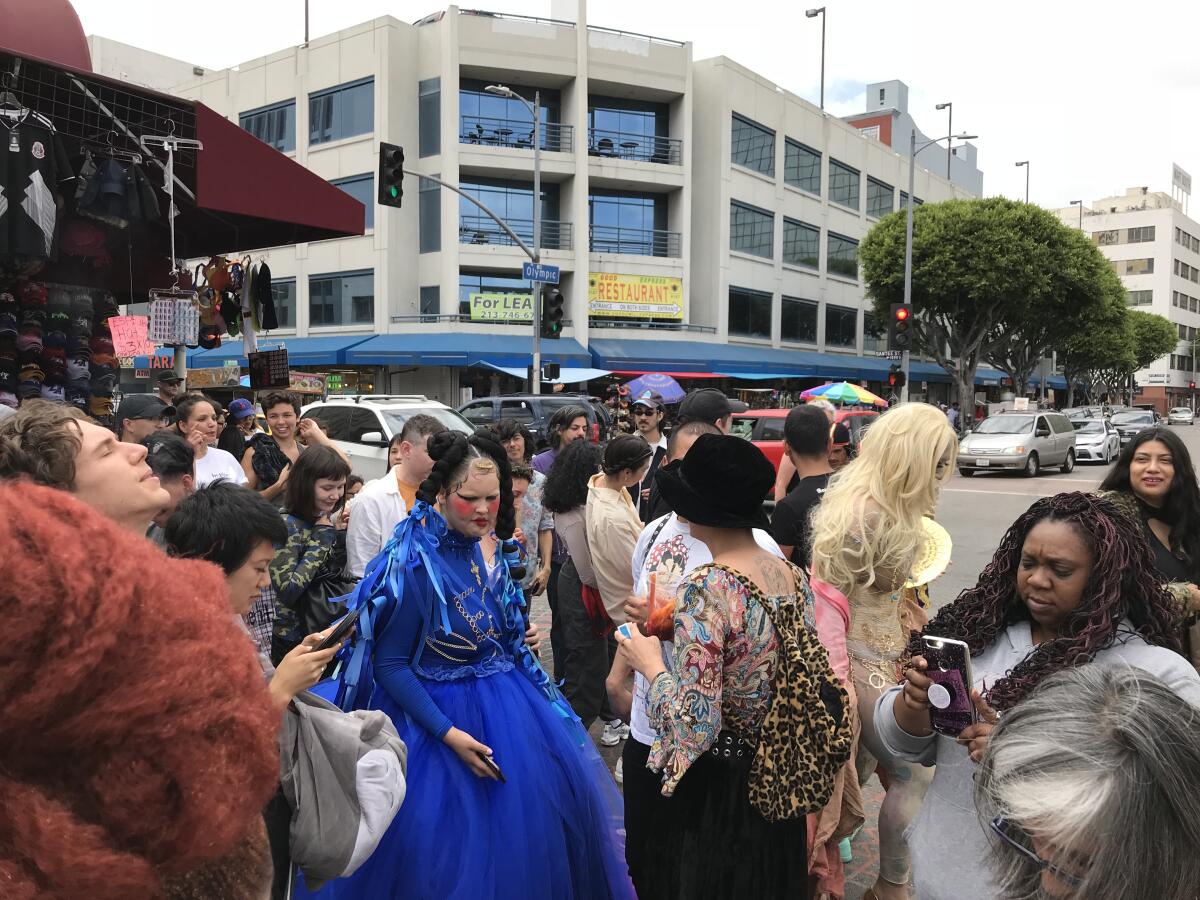
But the key event in her short artistic career was pretty much her own doing: “Haus,” the immersive installation she created at the Little Tokyo Art Complex in 2017.
Ruiz maintained a studio in the complex. One day, the manager mentioned to her that she was interested in opening up the gallery space during Downtown Art Walk. Ruiz, who was still working on her fashion at the time, jumped at the opportunity. But she wasn’t content with showing off a few images or a video.
“I want to make a house,” she told the manager. “I want to make a whole piece and each room will be monochromatic and each room will represent something of myself.”
The challenge: she had three weeks to create everything. The budget: zero.
At MASS MoCA, exhibitions by L.A.’s Rafa Esparza and Tijuana’s Marcos Ramirez, a.k.a. “ERRE,” examine the lines that divide — and the new identities they create.
So Ruiz set about scavenging whatever domestic objects she could lay her hands on: dressers, tables, mirrors, chairs, lamps, an old TV and even a dildo. She enlisted the help of her mom and stepdad who run a handyman business and could help with installation. (“They are always there for me,” she says.)
She dipped into her rent money to pay for supplies. When a man rear-ended her car and gave her $1,200 cash for repairs, Ruiz said she asked herself, “Gabby, what are you going to do? Fix your car? Or do the show?”
She did the show.
The result was a series of domestic environments — a bedroom, a sitting area, a dining room — each painted in Crayola shades of blue, yellow, red or green. All of the furniture was coated with insulating foam, giving everything a lumpy, distorted appearance. Embedded in the red room was a TV with a hallucinatory work of video that featured Ruiz, also in red.
It was home — an absolutely phantasmagoric vision of it.
The opening was a minor sensation, attracting several hundred people and generating coverage in a handful of pop culture blogs. Ruiz managed to make back her rent money by selling beer at the reception.
That show, in combination with her performances, have drawn increasing amounts of institutional attention.
Ruiz was featured in the traveling exhibition “Bridges in Times of Walls: Chicano/Mexican-American Art From Los Angeles to Mexico” at the Museo de Arte Carrillo Gil in Mexico City in 2018. And late last year she was invited to perform at Casstl, a nonprofit art space in Antwerp run by artists Carla Arocha, Stéphane Schraenen and Luc Tuymans.
In the increasingly buttoned-up, business-like art world, her work feels like a jolt of electricity: the wild colors, the space-age ensembles, the theatrical makeup.
“She’s fearless,” says Tompkins Rivas. “She reminds me of artists like Patssi Valdez, especially during the time when she was in Asco and there was a lot of self-fashioning. There is a tradition of that, making the exterior of the self part of their practice.”
The artist says she hopes to make work that reaches a broad audience. “I don’t want to be the person who makes the splash on the wall, then is all pretentious about it,” she says.
It’s hard to imagine Ruiz being pretentious.
The video installations at VPAM find the strange in everyday life: Shots of the artist going in and out of a room. Other footage of her at a rave. Ruiz laughing and scowling. Plus, there’s a snippet of the first video ever uploaded to YouTube, which shows a kid saying random things about elephants at the San Diego Zoo — a tribute to one of her most important sources of information.
“We do everything DIY,” she says. “My university is YouTube university. That’s how I learn everything.”
Gabriela Ruiz: Full of Tears
More to Read
The biggest entertainment stories
Get our big stories about Hollywood, film, television, music, arts, culture and more right in your inbox as soon as they publish.
You may occasionally receive promotional content from the Los Angeles Times.
